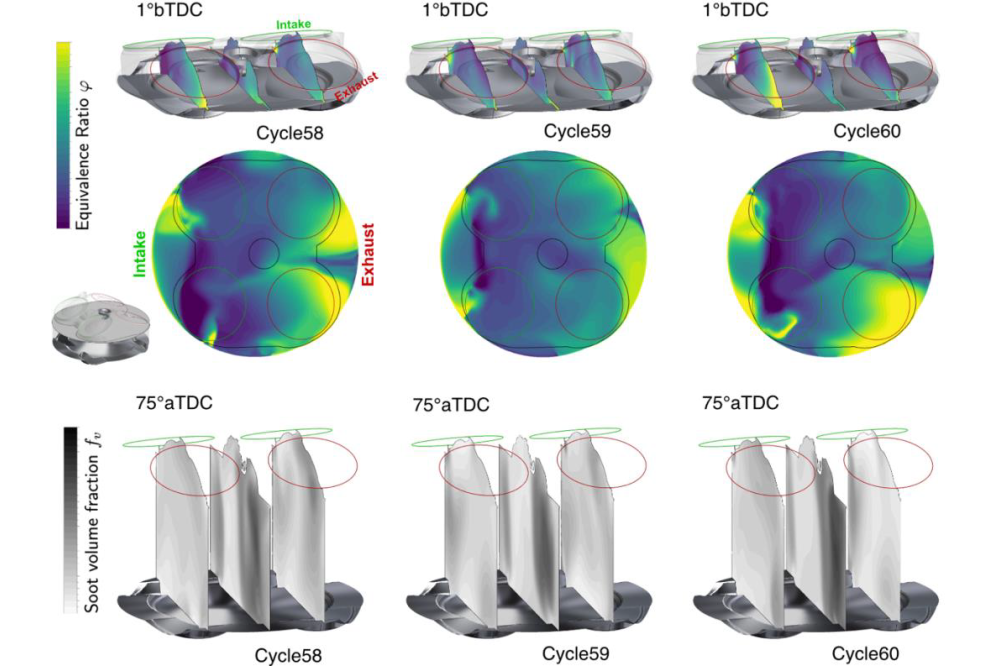CFD Analysis of Particle Emissions During Highly Transient Engine Operation
Introduction
Soot is an unwanted particulate pollutant with detrimental impact on the human health and climate change. Its emission is therefore strictly limited by legislation. One part of the legislation are measurements under real driving conditions, the so-called Real Driving Emissions (RDE). Pollutant measurements under these conditions are characterized by distinctive peaks corresponding to specific events during the driving scenario. In order to reduce overall emissions, it is therefore necessary to reduce such emission peaks.
New developments in computational fluid dynamics (CFD) and the availability of increasing computational resources enable the detailed simulation of emission sources even in complex geometries. CFD is therefore an excellent tool for real-world driving emissions analysis. In this project, experimental test bed measurements and CFD simulations were therefore combined to perform a numerical and experimental cause-effect chain analysis of RDE-relevant emission-critical engine transients and to derive possible emission reduction measures.
Methods
The widely used and well established CFD solver ANSYS CFX is used for the investigations in this project. The code enables the use of state-of-the-art methods for turbulence, multiphase, and combustion modeling while maintaining competitive performance. For the mixture and
combustion processes a G-Scalar combustion model with tabulated chemistry is used. The tabulation strategy is adapted to take important soot precursors into account.
For the detailed prediction of soot, a quadrature-based method of moments (QMOM) approach is applied. For this, the STFS institute developed a numerical framework for turbulent reacting and sooting flames. The framework includes all relevant libraries and is integrated into the CFD code via junction box routines. To enhance the coupling, the routines make direct use the ANSYS CFX internal memory management system (MMS).
Results
A framework for 3D-CFD transient multi-cycle simulation of emission-critical engine scenarios was successfully developed and evaluated. For this purpose, an emission-critical event previously identified on the dynamic engine test bed was measured and transferred to the framework with the appropriate boundary conditions. A total of 31 consecutive engine cycles of the transient were calculated and combined with experimental data to perform a cause-and-effect chain analysis. To isolate possible causes for the increased particulate emissions, the framework was further used to analyze sensitivities of the scenario and derive possible reduction measures. Finally, the identified measures from the CFD framework were transferred back to the test bed and evaluated.
Discussion
The results obtained demonstrate very well how state-of-the-art methods can already be used today to gain further insights into ongoing processes inside the engine during transient operation. With the performed cause-and-effect-chain analysis, two essential soot-promoting aspects in the transient could be identified. While deficiencies in the fuel-air ratio promote an initial increase in emissions, it was shown that the timing of the injected fuel mass in particular was decisive for the observed emissions. The analysis was also able to interpret observations related to an occurred knock event and evaluate its potential for particulate emission. For this purpose, the combined approach was crucial, since neither the experiment nor the CFD simulation alone was able to measure resp. model all necessary effects.
The identified trends of the derived measures from the CFD, especially for the injection strategy, could be confirmed when transferred to the dynamic engine test bed.
To further evaluate the methodology, the combined numerical and experimental approach needs to be applied to additional driving scenarios. For this purpose, with the upcoming EURO7 legislation, transient scenarios with cold start and oxygenated fuels will play a particular role.




